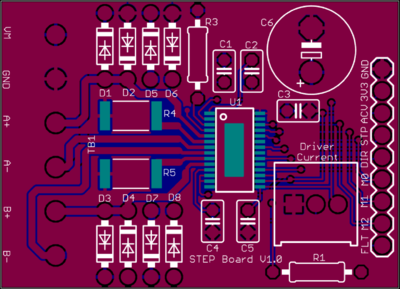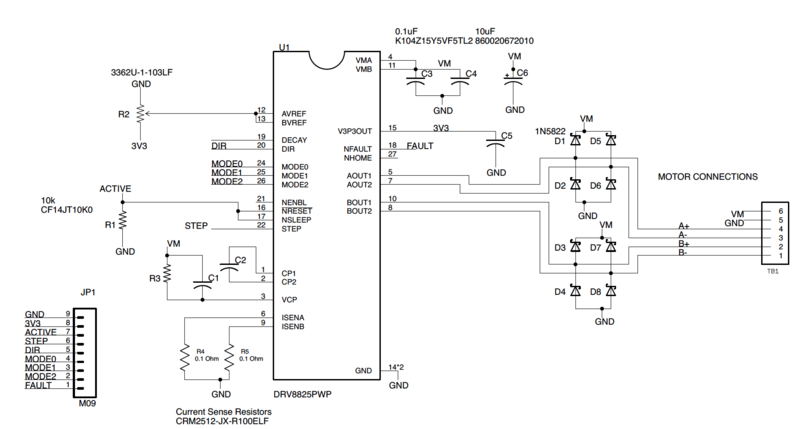Difference between revisions of "Stepper Board"
(Created page with "...Back to Projects: 400px = The RTC Board = == Introduction == Based on the low cost easy to use Real Time Clock IC M...") |
|||
| (14 intermediate revisions by the same user not shown) | |||
| Line 1: | Line 1: | ||
...Back to [[Projects:]] | ...Back to [[Projects:]] | ||
| − | [[File: | + | [[File:stepperGerber.png|400px]] |
| − | = The | + | = The Stepper Board = |
== Introduction == | == Introduction == | ||
| − | + | This board is based on the [http://www.ti.com/lit/ds/symlink/drv8825.pdf DRV8825] Stepper Motor Driver. It works with standard x4 wire bipolar stepper motors. | |
| + | * Motor Voltage Supply from 8.2V to 45V | ||
| + | * Phase Current up to 2.5A, but ~1A is more realistic without a heatsink and fan | ||
| + | * Built in Step Controller, so strap the mode pins for the step mode: Full, Half, and Micro stepping. | ||
| + | * Easy control from a Microcontroller, digital pins to set the direction, enable the part, and step the motor. | ||
| + | * Fault Output Pin broken out and max current setting with a trim pot | ||
| + | Note that this board breaks out clamping diodes for each of the motor connections - these should not be needed, but I added them in for experimentation purposes. | ||
| − | [[File: | + | == Schematic == |
| + | |||
| + | <span style="color:red">Do not use the 3V3 to power your project!</span> The active pin needs to be pulled HIGH in order to turn on that 3V3 rail from the board... this was an error in the design, so for now, the board requires an external power supply for the motor and a power supply for your control electronics (3V3/5V). | ||
| + | |||
| + | [[File:stepperSch.png|800px]] | ||
| − | |||
| − | |||
== Purchase == | == Purchase == | ||
| − | + | given to Patrons ... | |
== Parts == | == Parts == | ||
| − | + | Parts can be downloaded [[:File:StepBoardV1.xlsx|HERE]] and uploaded into [https://www.digikey.com Digikey] | |
== Assembly == | == Assembly == | ||
| − | + | Coming Soon... | |
| − | |||
| − | |||
| − | |||
| − | |||
| − | |||
== Tutorials == | == Tutorials == | ||
| + | Little refresher on how stepper motors work: | ||
{{#evt: | {{#evt: | ||
service=youtube | service=youtube | ||
| − | |id=https://www.youtube.com/watch?v= | + | |id=https://www.youtube.com/watch?v=ePSCZ_DtF7c |
|dimensions=560x315 | |dimensions=560x315 | ||
}} | }} | ||
| + | Tutorial using this board: | ||
{{#evt: | {{#evt: | ||
service=youtube | service=youtube | ||
| − | |id=https://www.youtube.com/watch?v= | + | |id=https://www.youtube.com/watch?v=d-IKDQ5vqnU |
|dimensions=560x315 | |dimensions=560x315 | ||
}} | }} | ||
| + | Resources: | ||
| + | The sample [http://kevindarrah.com/download/arduino_code/StepBoardTest.ino CODE] | ||
Latest revision as of 12:44, 18 June 2017
...Back to Projects:
Contents
The Stepper Board
Introduction
This board is based on the DRV8825 Stepper Motor Driver. It works with standard x4 wire bipolar stepper motors.
- Motor Voltage Supply from 8.2V to 45V
- Phase Current up to 2.5A, but ~1A is more realistic without a heatsink and fan
- Built in Step Controller, so strap the mode pins for the step mode: Full, Half, and Micro stepping.
- Easy control from a Microcontroller, digital pins to set the direction, enable the part, and step the motor.
- Fault Output Pin broken out and max current setting with a trim pot
Note that this board breaks out clamping diodes for each of the motor connections - these should not be needed, but I added them in for experimentation purposes.
Schematic
Do not use the 3V3 to power your project! The active pin needs to be pulled HIGH in order to turn on that 3V3 rail from the board... this was an error in the design, so for now, the board requires an external power supply for the motor and a power supply for your control electronics (3V3/5V).
Purchase
given to Patrons ...
Parts
Parts can be downloaded HERE and uploaded into Digikey
Assembly
Coming Soon...
Tutorials
Little refresher on how stepper motors work:
Tutorial using this board:
Resources: The sample CODE

